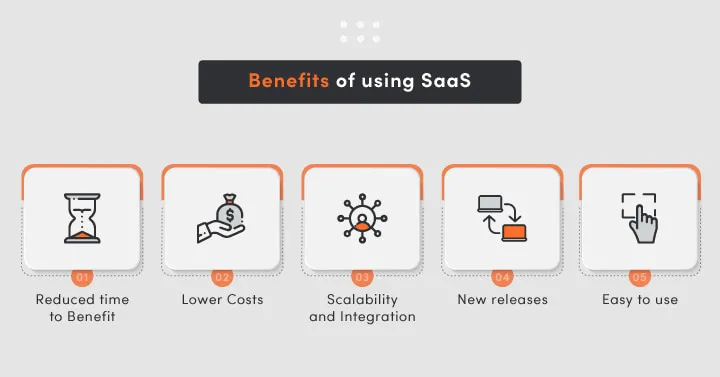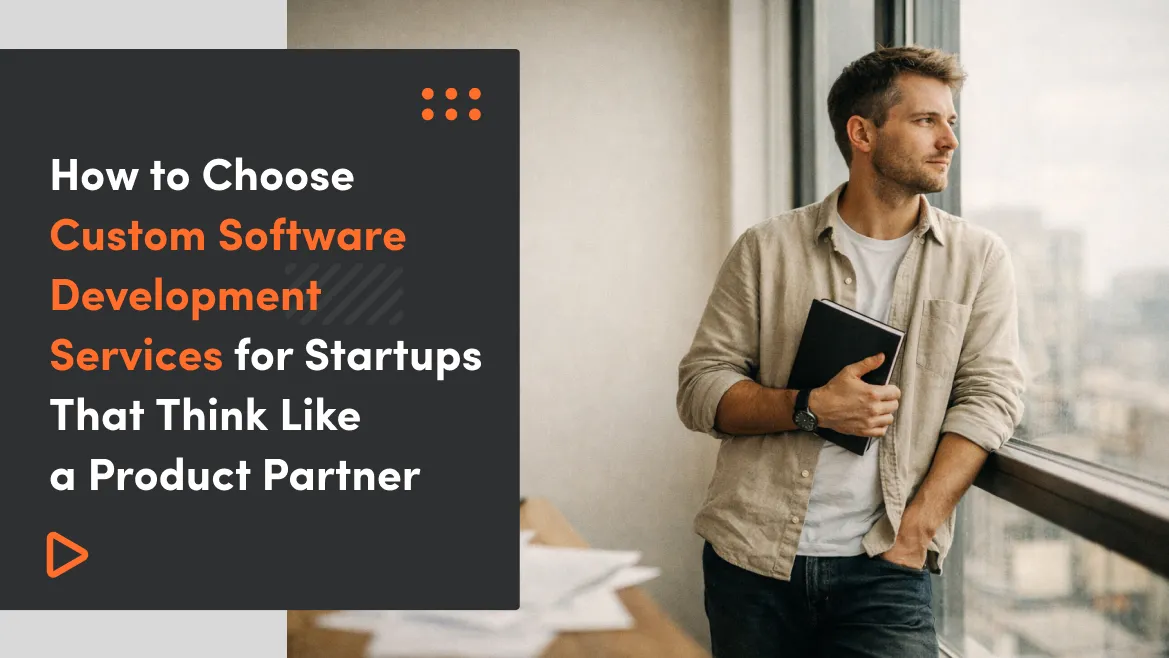Looking for SaaS development best practices that actually scale? This guide shows what really works. Start simple. Make security the default. Automate CI/CD and focus on what truly matters. You’ll learn how to pick the right architecture and ship updates with no downtime. You’ll also see how to design billing that builds trust and track per-tenant performance. That way, your product grows fast without losing quality. Plus, pragmatic tips on UX, data, and team scaling.
-
Start simple, evolve with data. Start with a modular monolith. Scale your SaaS architecture later—only when the metrics show it’s needed.
-
Security is not optional. Follow SaaS security best practices from day one. Encrypt data, enforce secure access, and run automated audits.
-
Automate everything. CI/CD, testing, and monitoring lower development costs. They also help prevent downtime in SaaS applications.
-
Design for users, not teams. Good UX and guided onboarding improve user adoption. Continuous user feedback helps reduce the support load.
-
Scale smart, not fast. Build a skilled core team. Work with trusted partners to grow efficiently and keep quality high.
What are Saas development best practices and which key components matter most in a modern SaaS app?
Start simple and prove it. Start with a modular monolith and build security in from the start. Use CI/CD and clear tenant isolation. Track the SRE golden signals from day one. Version everything, measure everything, automate everything. Follow the 12-Factor App principles for better dependency management. They help ensure scalability and easy maintenance from the start. Use a manifest file and tools like Docker to keep development and deployment smooth.
From a practical point of view, a solid SaaS app follows a few non-negotiables. Keep the architecture simple until the data proves you need more. Add security early and use automation to ship faster. That’s the backbone of most SaaS applications that scale without drama. It sounds simple because it is. But skipping these steps costs teams months in rewrites and fixes. Choose a clear monetization model to keep your SaaS product sustainable. Define your unique value proposition so it stands out in the market.
If you’re new to the SaaS concept, remember why the model wins. SaaS applications speed up delivery. They lower costs with multi tenancy. They scale easily. They update often. They enable quick proofs of concept. Those five benefits are only real if the foundations hold. Otherwise, you end up trading data-center headaches for production fire drills. Market research and idea validation are key first steps in SaaS development. They help match your product’s benefits with real user needs. SaaS development often includes third-party integrations. Plan them early to improve features and meet user expectations.
Tie the foundations to clear business objectives and metrics. Track AARRR: activation, retention, revenue. Track SRE metrics: latency, traffic, errors, saturation. This helps product and engineering speak the same language. Set clear SLO and SLI goals to make reliability visible. Run A/B tests and check cohort trends to see adoption over time. Build feedback loops with surveys and analytics to guide the roadmap and stay aligned with user needs. Regular maintenance and proactive approaches can prevent issues and enhance SaaS application reliability.
Here’s the evergreen “starter pack” that underpins most best practices:
- Architecture: modular monolith, clear service boundaries, API/event versioning, migration scripts.
- Security starts with shift-left checks. Control access. Use encryption in transit and at rest. Run OWASP ASVS scans often. Embed security best practices at every stage of development, known as DevSecOps.
- Data: additive schema changes, soft-delete + purge jobs, backups + restore drills (PITR).
- CI/CD: trunk-based flow, short-lived branches, automated tests, feature flags, canary/blue-green.
- Billing: idempotent usage ledger, pro-rations, dunning, audit trails.
- Observability: structured logs, traces, metrics with exemplars, tenant-level dashboards.
Use automated testing and code reviews to keep code quality high. This makes each release stable and reliable.
If you want help implementing the above with an experienced delivery rhythm, see our SaaS development services. A disciplined setup now saves far more than it costs later.
What are the key differences between a modular monolith and microservices for SaaS?
Pick a modular monolith first; split into microservices only when teams and traffic prove the need. Evolve to microservices; don’t start there. Release updates in small batches. It lowers risk and keeps scaling smooth.
When a modular monolith shines. You move faster with one deployable and one datastore. Clear internal modules keep things simple. This cuts costs and makes refactors easier as you test product-market fit. Design with clean service boundaries and contracts so scaling feels natural. After MVP validation, focus on feature development. Keep improving the app to meet growing user needs.

When microservices make sense. Choose microservices when teams need independent control or isolated scaling. Use them if compliance rules require strict separation. Watch for signals like slow builds or uneven scaling. Until then, remember that microservices add real costs in networks, deployment, and operations.
What pain tells you to split. Look for key differences you can’t ignore:
- Hot endpoints at p95 > target while the rest is fine (capacity skew).
- Code ownership conflicts between squads (merge hell).
- Feature flags and releases stepping on each other (coordination tax).
- Security/compliance boundaries that require separate blast radii.
If two or more show up consistently, carve out a service with its own contracts and SLOs.
Platform capabilities to keep either path healthy. Version external contracts, publish deprecation windows, and automate schema changes. Keep an internal “platform” module for shared assets (auth, audit, messaging). With this discipline, you can start with a monolithic setup. Later, extract services only where it truly adds value. This avoids the risk of a full rewrite.
Comparison at a glance
Top 5 Advantages of Using SaaS (Clear, Fast, Scalable)
For modern digital businesses, SaaS isn’t just a delivery model—it’s the operational backbone. SaaS applications fit modern teams. Cloud-native tools give flexibility, instant updates, and global reach. The right SaaS platform lets you move fast and stay stable, secure, and low cost.
The success of any SaaS solution depends on balance. A strong SaaS architecture removes local infrastructure limits and scales as demand grows. Built-in data encryption and secure access protect sensitive data and ensure compliance. These elements turn a SaaS solution into a lasting growth plan. They improve efficiency, build trust, and raise customer satisfaction.
Here are the five main benefits a SaaS solution offers today. Each one is built on speed, reliability, and trust.
- Reduced time-to-value. Modern SaaS applications launch within hours on a managed SaaS platform. This helps teams deliver features faster and prove value sooner.
- Lower operating costs. Shared saas architecture (multi-tenant) trims infra, licensing, and maintenance. You pay for usage, not idle capacity.
- Elastic scale and easy integrations. Cloud-native services scale with demand and integrate easily with other tools. This keeps your SaaS platform flexible as it grows.
- Security by default. Built-in controls protect sensitive data through data encryption in transit and at rest. This lowers the risk of breaches compared to on-premise setups.
- Higher adoption and retention. Use product analytics to track user behavior and spot patterns. Use customer relationship management flows for onboarding and renewals. They help keep users engaged and lower churn.
Try our developers.
Free for 2 weeks.
No risk. Just results. Get a feel for our process, speed, and quality — work with our developers for a trial sprint and see why global companies choose Selleo.
How do you define the project scope and core features for a SaaS product that users love?
Start small and test fast. Build an MVP that solves one clear problem and test it with real users using interactive demos. Expand only when data supports it. The best SaaS teams trust continuous user feedback and measurable results, not intuition. Use surveys, interviews, or MVP testing to confirm market interest before full development. Scope grows by evidence, not by opinion.
A wrong project scope is the fastest way to blow a budget. I’ve seen teams spend months on feature development that no one used. The right scope keeps your time-to-market short and your focus clear. A successful MVP captures the essence of value through a few key workflows that users complete often. When those flows work flawlessly, everything else can follow naturally.
Defining the scope isn’t just a product decision—it’s a collaboration. Your marketing team identifies which customer problems to solve first. Designers and engineers then define quick ways to test those ideas. They build a feedback loop to test demand, usability, and pricing before scaling. Create user personas to guide design and feature choices. This helps the product match what the audience truly needs.

Think of it like building a bridge: you don’t pour all the concrete before testing one span. In SaaS, that “span” is your MVP. It connects an actual customer need with measurable user satisfaction. When every iteration starts with real user feedback, you evolve your product, not guess at it.
If you need a clear visual process for mapping MVP flows and UI prototypes, read how to design a SaaS application. It explains design systems and onboarding UX. It also shows how key workflows turn new users into loyal ones.
How should data security and data encryption be embedded into your security model from day one?
Ship with security built in. Encrypt data in transit and at rest. Enforce least-privilege access and run automated scans and audits from the start. In modern SaaS security, prevention is a product feature, not a process. Security you bolt on will bolt off. SaaS environments store large amounts of sensitive data, which attract cybercriminals. Proactive security measures are vital. Two-factor authentication helps ensure each login is real.
SaaS security starts with visibility and trust. A strong model protects sensitive data at every layer—from app code to cloud infrastructure. Make it default, not optional. Use TLS for every connection, encrypt stored data, store secrets safely, and block unsafe builds in CI/CD. When access rules stay strict and logs are clear, secure access is easy to measure. That’s when security moves from theory to proof.
Teams often worry that implementing strong security measures will slow delivery. In practice, the opposite happens. Shift-left methods and automated checks add measures early. Continuous audits prevent late firefighting. You ship faster because your security concerns are handled before release. Policy-as-code, dependency scans, and signed builds make SaaS security best practices part of daily work. Security is built in, not added later.
Every system should regularly identify vulnerabilities—not just fix symptoms. Static and dynamic scans, penetration tests, and peer reviews find weak spots early. Following OWASP ASVS and ISO 27001 or SOC 2 keeps your SaaS security strong. If your platform handles regulated data, record GDPR and HIPAA rules. Note how you manage exports, deletions, and incidents.
Security is always shared between your team and your SaaS provider. Use CASB tools where native controls fall short. Enforce MFA for admins, SSO for customers, and short-lived credentials for sessions. Implement measures that log every privileged action for traceability. Regular tests, quick fixes, and automated alerts keep security concerns small and predictable.
AI brings both power and risk. Apply DevSecOps rules to models and prompts: classify data, mask PII, log usage, and work only with vendors covered by DPAs. For a deeper look into secure automation and model governance, explore our Artificial Intelligence Solutions. They outline practical ways to embed safety in AI-driven workflows without sacrificing innovation.
In short: protect early, encrypt always, and automate trust. That’s the foundation of reliable SaaS security.
What is the right access control for customer data across tenants?
Separate by policy and prove it in code. Use row-level security for many tenants, least-privilege roles, and SSO/SAML with SCIM for enterprise identity. In SaaS applications, usually built on multi-tenant setups, strong isolation is a must. Secure access is just as essential. Isolation is a design choice, not a hope.
Start at the database. Postgres RLS enforces tenant filters, so one bug can’t expose another customer’s data. Pair it with RBAC or ABAC roles that follow the least-privilege rule. Secure access means every query and action is limited to what the user truly needs. Access should fail safe—no wildcard permissions or shared admin tokens.
Identity can’t be an afterthought. Single Sign-On cuts password fatigue, while SAML and SCIM sync user roles with a company’s identity provider. Enterprises handle their own onboarding and offboarding without tickets. Add two-factor authentication for sensitive actions. It keeps sessions safe and maintains secure access under heavy load.
Good access control shows in your logs. Audit trails should answer who did what, when, and under which role. Clean logs mean quick reviews and easy trust. Build them early, not after your first incident.
Prove isolation with RLS, identity with SSO/SAML, and control with logs. That’s how saas applications typically maintain tenant trust and compliance at scale.
Which saas architecture and multi-tenancy choice fit your stage and saas usage patterns?
Match your setup to your scale. Use Row-Level Security (RLS) for small tenants. Choose schema-per-tenant for noisy or regulated clients. Pick database-per-tenant for large or residency-bound customers. Isolation scales with evidence, not ambition.
Building a SaaS product is about balance. Your architecture decides how fast you scale, how much you spend, and how safely you handle data. The wrong choice can turn simple maintenance into a full-time job. The right one lets you grow without rewriting the core every six months.
I’ve seen early teams over-engineer from day one. They start with microservices and complex multi-tenant setups “just in case.” Most end up fighting network noise instead of focusing on users. Start simple, evolve with proof. A well-structured modular base beats premature scaling every time.
Your multi-tenancy approach defines how customer data lives inside your system.
In a shared model, many clients (tenants) use the same app and infrastructure—but their data stays isolated.
- RLS (Row-Level Security) adds isolation at the row level. It’s cheap and effective for startups with many small customers.
- Schema-per-tenant gives each client its own schema. It costs more but supports noisy or regulated clients who need extra guardrails.
- Database-per-tenant offers maximum isolation. It fits big enterprises, healthcare apps, or regions with strict data residency laws.
Think of it as an investment ladder: you start low-cost and move up when metrics justify it. Each step increases operational costs but also resilience and trust.
Data storage grows, but so does clarity—each tenant’s data lives in its own lane.
Modern cloud-native architectures make this evolution smoother. You can start monolithic and gradually add shards, partitions, or caching layers (like a CDN) as usage grows. When your platform capabilities mature, scaling becomes predictable instead of reactive.
For a deeper guide on scaling processes, read how to scaling SaaS and build a successful software team. It outlines how strong team design supports technical scaling.

What continuous integration and delivery patterns reduce development costs and risk?
Automate from infrastructure to release. Use IaC and CI/CD with short-lived branches, feature flags, and progressive delivery (canary or blue-green) to ship safely every day. Fast is fragile until it’s automated.
Modern SaaS teams lower development costs by shipping small, safe changes. Continuous integration (CI) joins each code change into one tested flow. Continuous delivery (CD) then automates the deployment process. Together they turn risky releases into predictable, reversible updates.
Infrastructure as code (IaC) tools such as Terraform create stable environments. Pipelines build, test, and deploy automatically, using feature flags for controlled rollouts. Progressive delivery uses canary or blue-green deployments to keep uptime close to 100%. It also helps avoid manual and risky releases.
Even complex implementations become simpler with automation. Teams save time on complex tasks like billing and analytics. Pipelines handle builds and tests automatically. This discipline helps streamline operations and reduce human error during updates.
When resources are limited, partnering with experts in software outsourcing development helps implement these patterns faster. A solid CI/CD setup prevents downtime. It lowers risk and keeps releases running smoothly.
How to guarantee zero-downtime deployment for saas applications?
Swap traffic, not servers. Use blue-green or canary deployment with automated health checks. Add instant rollback to keep new releases invisible to users. Downtime is a choice; automation makes it optional.
Most SaaS applications run nonstop, so even a few minutes offline can hurt revenue and trust. The trick is running two environments—one live, one staging. Deploy to the idle version, test with real traffic, then switch routes when it’s healthy. Users never notice the handover. Health checks track latency and errors. If something fails, the rollback starts before customers notice.
I remember one launch where we released new billing logic behind a canary flag. Only five percent of users saw it first. In minutes, we saw an API timeout. We fixed it, redeployed, and scaled to all users—no downtime or panic. Zero-downtime deployment isn’t luck; it’s architecture backed by automation.
How do you design billing and subscription lifecycle so it won’t haunt you later?
Treat billing as part of trust. Track usage with an immutable ledger and keep each operation idempotent. Automate pro-rations, handle dunning, and show per-tenant margins early. Revenue breaks where trust breaks. Use tiered pricing models that grow with your customers. This approach keeps revenue aligned with their success and satisfaction.
Billing sits at the edge of your customer relationship. One failed charge or wrong invoice can undo months of customer success work. In every SaaS app, the billing flow should be auditable and predictable. Each API call must include an idempotency key, so retries don’t double-charge users. Immutable ledgers protect history from accidental edits, keeping finance and engineering aligned.
When trial users upgrade or cancel, reconciliation should be automatic. Use HMAC webhooks to verify events from payment gateways like Stripe. This step helps prevent duplicate or fake updates. Pro-rated invoices, dunning flows, and clear receipts boost customer satisfaction and reduce churn. Keep billing logic simple and fair. It makes SaaS implementation smooth for teams and systems.
Delaying billing design is a hidden debt. Teams that “do it later” often spend months untangling edge cases, refunds, and tax errors. Keep the subscription lifecycle clear: subscribe, upgrade, cancel, re-subscribe. This clarity keeps customer interactions simple and transparent. It turns finance from a blocker into a product advantage.
For complex use cases or fintech-grade compliance, partner with experts in custom FinTech software development. Smart automation and clear reconciliation cut SaaS spend. They also simplify business processes and protect users and profit margins.
How to implement observability that surfaces key components and performance metrics per tenant?
Start where it matters. Track logs, traces, and metrics using golden signals. Build per-tenant dashboards to link reliability, cost, and user experience. What you can’t see, you can’t improve.
Observability is what keeps SaaS teams honest. Without it, you can’t maintain SLOs, find regressions, or control costs. Many confuse it with Google Analytics, but telemetry goes deeper. It tracks key metrics that show system health, not just clicks. Logs show what happened, and traces reveal how requests move through services. Metrics warn when performance begins to drop. Together, they reveal weak spots before users notice.
If I’ve learned one thing, it’s that visibility scales with focus. You don’t need full coverage at first. Focus on key components that affect the user journey, such as sign-up, billing, and API speed. Tag them with OpenTelemetry spans and use exemplars to tie slow traces to real users or tenants. Over time, those signals form the heartbeat of your platform.
Per-tenant dashboards turn noise into insight. They show which customers face lag or usage spikes. They also reveal how these issues affect your margins. When alerts fire on symptoms, not internals, teams react faster and smarter. That’s how operational efficiency becomes measurable instead of mythical.
For the front end, telemetry from React shows rendering delays. It also helps find points of user friction. Partnering with a seasoned react development company helps connect UI metrics with backend traces—so performance, not guesswork, drives product decisions.
How do UI/UX and onboarding keep users engaged and reduce support load?
Design for empathy, not decoration. Deliver a responsive and accessible interface with guided onboarding and self-service help. Early wins in the first week build lasting user retention. Good UX is cheaper than bad support. Focus on self-service customer support. It boosts customer satisfaction and lightens the workload for support teams.
In SaaS, the interface is the product. Every confusing button, missing label, or slow page adds friction and churn. A polished UI/UX isn’t just aesthetic—it’s how users learn, trust, and stay. Interactive demos and onboarding walkthroughs reduce the need for manuals or support tickets. When user adoption happens naturally through design, retention becomes sustainable rather than forced. Good user training helps teams use the SaaS solution with confidence. It cuts confusion and helps them get the most value from the product.
A great saas website or app feels natural across devices. Accessibility matters. WCAG 2.1 AA standards, keyboard shortcuts, and clear focus states make navigation easy. Add localization (i18n/RTL) to support global users. Include command palettes to help advanced users work faster. Every detail helps keep users engaged without adding new complexity.
Many teams delay design, calling it “phase two,” but that’s how churn starts. Poor onboarding hides value, floods support, and slows adoption. Guided tours and hints help users know where to click. In-app user feedback loops explain why each step matters. Over time, self-service replaces tickets, freeing teams to build instead of explain.
From my experience, small UX tweaks pay off fast. Faster loads, clear layouts, and accessible forms raise satisfaction and cut churn. For a deeper look at process-driven design, explore Selleo’s web design company services. They combine product strategy with accessibility and performance engineering, turning friction into growth.
How does data storage and lifecycle management prevent data breaches and fines?
Design for reversibility and proof. Update the schema step by step. Run point-in-time restores (PITR) every quarter. Automate GDPR and CCPA export and deletion tasks. Backups don’t matter until a restore does.
Strong data storage strategy is risk control, not paperwork. Practice PITR on a schedule and store evidence of successful restores. That turns data security from guesswork into a routine process. It also reduces the impact of data breaches.
Lifecycle is policy plus automation. Start with soft-delete to stay safe. Then run purge jobs that follow retention rules and residency controls. Organizations manage subject-access exports and verified deletions through audited jobs, not ad-hoc scripts. In regulated learning products, see our work in e-learning software development for privacy-first patterns.
Tech choices help but don’t replace process. Postgres for integrity, Redis for speed, Elasticsearch for search—each logged and recoverable. Test your restores and confirm purges. Keep residency records clear. Small routines today stop complex implementations later.
What’s the pragmatic path for SaaS companies to scale teams and delivery without losing quality?
Build a small, skilled core and expand with trusted partners. Blend in vetted experts through staff augmentation, work in two-week sprints, and use clear SLAs for accountability. You can scale speed—but never skip discipline. Build a customer success team to boost user adoption and meet client needs. This approach drives long-term satisfaction and retention.
Scaling isn’t just hiring more people; it’s expanding without breaking what already works. Many SaaS companies grow fast, then slow down under coordination overhead. A pragmatic model keeps the core team focused on architecture and product vision. It adds capacity with expert partners and trusted SaaS vendors. Staff augmentation helps handle peak workloads and complex projects without permanent headcount.
From my own experience, teams that scale gradually maintain better quality. Two-week sprints give predictable cadence and visibility. SLAs define expectations—delivery speed, bug turnaround, communication. This hybrid approach works because it combines internal ownership with external flexibility. You can scale up when needed and scale down easily. This keeps alignment across all SaaS offerings and development streams.
Some founders fear “vendor lock-in.” The truth? The risk drops when the client owns the IP and the process is transparent. Selleo’s model ensures all code, documentation, and access remain in your hands. That’s what makes collaboration safe for a growing SaaS company. It builds trust through clarity, not dependency.
When should you choose software outsourcing development vs in-house?
Keep leadership, architecture, and security close. Outsource repeatable or specialized work that benefits from external efficiency. Delegate output, not ownership.
In early growth, hiring fast can kill focus. Outsource routine or complex tasks like testing, integrations, or DevOps. This lets your core team focus on what makes the product unique. Use RACI mapping to set clear roles before contracts begin. When managed well, software outsourcing development accelerates delivery without losing control.
The rule is simple: in-house drives innovation; outsourcing multiplies execution. Smart saas companies combine both to reach scale faster and safer.
A solid SaaS tool starts with a modular architecture, built-in security, and automated CI/CD. Add clear user access controls, strong observability, and a flexible billing system. These key elements make it easy to grow without rewriting your product every few months.
Horizontal scaling involves adding new instances or containers instead of overloading existing ones. Automated load balancers and monitoring keep uptime near 100%, while CI/CD pipelines ensure that new nodes deploy fast and safely.
Use role-based permissions and row-level security (RLS) to isolate data per tenant. Combine SSO or SAML for enterprise identity and MFA for admins. Strong user access policies protect trust and simplify audits.
Mobile apps extend SaaS reach and retention. They bring your product to users anywhere, supporting real-time notifications and offline use. Building them on the same API layer as your core SaaS tool keeps features consistent across devices.
Embedding DevSecOps, automated tests, and encrypted data flows from day one reduces downtime, cuts costs, and prevents incidents before they happen. Security and automation together make all the difference between scaling smoothly and firefighting releases.





